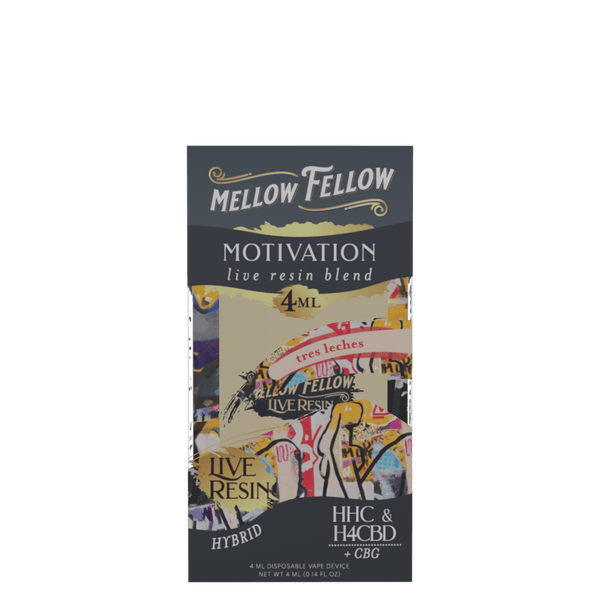Working Out High: A Science-Backed Guide to THC Pre-Workouts

Sweating, grooving, and finding your flow during a workout can be challenging, especially when motivation is low or recovery feels endless. But what if there was a natural way to push through plateaus, enhance mind-muscle connection, and even make those grueling cardio sessions feel more enjoyable?
The rising trend of THC pre-workouts is changing how fitness enthusiasts approach their gym sessions, with cannabinoids entering the conversation alongside traditional supplements like caffeine and creatine.
While the idea of hitting the gym after hitting a vape might seem counterintuitive to some, a growing community of fitness enthusiasts is discovering the potential benefits of carefully dosed cannabinoids before exercise.
This is about harnessing specific effects from particular cannabinoid blends to enhance focus, reduce perceived exertion, and potentially elevate your workout experience.
At Mellow Fellow, we've noticed more customers incorporating our Motivation Blend and energy-focused formulations into their fitness routines.
So, we decided to create this science-grounded guide to working out high, covering everything from dosing strategies to strain selection and the real physiological effects behind the experience.
Read on to find out everything you need to know about the benefits of THC pre workout.
Key Takeaways
-
THC interacts with the endocannabinoid system to influence mood, pain perception, and workout enjoyment.
-
Low to moderate doses of THC may help reduce perceived exertion and boost motivation.
-
Different blends support different workout types—Charged for cardio, Clarity for focus, Recover for post-workout.
-
Timing and dosage are crucial—start low and align consumption with your workout type.
-
Cannabinoids may aid recovery by supporting inflammation regulation and sleep quality.
-
THC is not recommended in high-risk situations like heavy lifting without a spotter or extreme environments.
-
Gym etiquette and legal rules must be respected when using cannabinoids in public or group settings.
How THC Affects Your Workout: The Science Behind Exercise and Cannabinoids
The relationship between cannabis and exercise goes deeper than just feeling good while moving. When you consume certain cannabinoids before a workout, you're actually triggering a complex cascade of physiological responses that can influence everything from pain perception to energy availability.
When THC enters your system, it interacts with your body's endocannabinoid system (ECS), a complex network of receptors that plays a role in regulating mood, appetite, pain sensation, and even exercise-induced euphoria.
Interestingly, this system significantly overlaps with what athletes often call "runner's high", that blissful state originally attributed solely to endorphins.
-
We've observed that customers using our Charged Blend before cardio sessions report feeling "in the zone" faster and maintaining that state longer. This isn't surprising when we consider the neurochemical mechanisms at play, as cannabinoids can help modulate the dopamine reward system, potentially making repetitive exercise feel more rewarding and less monotonous.
If you’re looking for tips on how to motivate yourself to run, this guide offers practical strategies to boost your consistency and performance.
However, it’s important to note that THC’s effects on exercise aren’t all straightforward. At higher doses, THC can increase heart rate and potentially reduce maximum exercise capacity in some individuals. This is why proper dosing and timing are crucial when incorporating cannabinoids into your fitness regimen.
5 Potential Benefits: When Cannabis and Fitness Work Together
The combination of cannabinoids and exercise offers several potential benefits when approached thoughtfully.
Based on both scientific literature and feedback from our fitness-focused customers, here are the most significant positive effects you might experience:
1. Reduced Perceived Exertion and Increased Enjoyment
Reduced perceived exertion is perhaps the most commonly reported benefit.
Some cannabis users experienced reduced pain sensitivity during exercise, potentially allowing them to push through discomfort that might otherwise limit their workout. A recent study backed this up, with participants reporting lower pain levels during exercise after consuming THC.
This doesn't mean you're magically stronger, but rather, your perception of effort might shift, making challenging sets feel more manageable. Studies show that THC can reduce how hard your workouts feel, making it easier to exercise for longer periods.
On that note, recent research also demonstrates that those who use THC pre workout often report higher enjoyment and satisfaction levels. Reports from the University of Boulder indicate that up to 70% of those who mix THC and exercise say that doing so increases their overall level of enjoyment they get from working out.
2. Enhanced Mind-Muscle Connection
Enhanced mind-muscle connection is another frequently cited advantage. Many bodybuilders and strength athletes who use moderate doses of cannabinoids before training report increased bodily awareness and better ability to "feel" the target muscles working during isolation exercises.
If you’re also looking for tips on how to naturally feel more awake and energized, this guide offers quick and simple solutions you can integrate into your routine.
3. Increased Creativity and Workout Variety
Several users of our Creativity Blend report bringing new variations and movement patterns into their workouts, breaking through monotonous routines that had stopped delivering results. This creative boost can be particularly valuable for preventing exercise plateaus.
4. Post-Workout Recovery
Post-workout recovery benefits represent another promising area. Some research indicates that certain cannabinoids have anti-inflammatory properties that could potentially aid recovery.
A recent study from the Journal of Cannabis Research with 620 participants reported that 77.6% of those participants felt that THC decreased post-workout recovery times and helped them recover faster.
5. Increased Motivation to Workout
THC can trigger the release of dopamine, the brain’s feel-good chemical. This boost in dopamine can make you feel more motivated, uplifted, and energized, which is why some people find it easier to get moving after using THC.
It can turn a workout from something that feels like a chore into something more enjoyable. Whether it’s going for a run, lifting weights, or even stretching, THC’s mood-lifting effects can help make exercise feel more rewarding and fun, encouraging you to stick with it.
It's worth acknowledging that while many experience these benefits, individual responses to cannabinoids vary dramatically based on factors like tolerance, body composition, exercise history, and the specific cannabinoid profile consumed.
What works perfectly for one athlete might be entirely wrong for another, which is why we emphasize experimentation with low doses when starting this practice.
Cardio vs. Strength Training: Different Workouts, Different Approaches
Not all workouts are created equal when it comes to incorporating cannabinoids. The ideal approach varies significantly between cardiovascular exercise and strength training, both in terms of dosing and cannabinoid selection.
For Cardio-Focused Sessions (Running, Cycling, Dance Fitness)
-
Cannabinoid Choice: Many users prefer sativa-dominant formulations with moderate THC and energizing terpenes like limonene and pinene (associated with alertness and respiratory benefits).
-
Effects: Helps maintain energy levels and makes repetitive movement more enjoyable.
-
Timing:
-
Take cannabinoids 15 to 20 minutes before starting your warm-up.
-
For longer cardio sessions, microdosing might be more sustainable than one large dose.
For cardio-focused sessions like running, cycling, or dance fitness, many users find success with sativa-dominant formulations that combine moderate THC with energizing terpenes.
Here’s what one user of the Charged Blend had to say when taking it before a gruelling run:
-
"When I take a small hit of the Charged Blend before my 5-mile run, I find that the 'wall' I usually hit around mile three disappears. My breathing feels more natural, and I stop checking my watch every 30 seconds."
For Strength Training and Resistance Work
-
Cannabinoid Choice: Users often prefer balanced hybrid formulations with moderate THC and additional CBD or CBG for their potential anti-inflammatory support.
-
Effects: Focuses more on enhancing mind-muscle connection rather than seeking euphoria.
-
Timing:
-
Take cannabinoids about 30 minutes before your first working set, after completing your mobility and warm-up routines.
-
Avoid taking too close to training, as it could impact coordination.
One powerlifter who uses our Clarity Blend before training sessions notes: "I don't use it on max effort days, but for volume work and accessory training, it helps me focus on feeling the muscles work rather than just moving weight from A to B."
The Key Takeaway: Adjust both your dosage and cannabinoid profile based on your workout type. What's optimal for a long trail run might be completely wrong for a heavy squat session.
Finding Your Optimal Dose: Start Low, Go Slow
The most common mistake people make when exploring cannabis as a workout aid is taking too much, too soon. This isn't surprising because the line between performance-enhancing and performance-reducing effects can be quite narrow with THC, especially for inexperienced users.
For first-time THC pre-workout users, we recommend starting with a minimal dose, far lower than what you might use in recreational settings. A single short inhalation from a low-THC product or 2 to 3mg of THC in an edible form (accounting for delayed onset) is an appropriate starting point for most individuals.
Keep in mind that your ideal dose will likely be different for different activities. You'll probably find that your preferred dose for a yoga session is very different from what works for high-intensity interval training.
To find your personal optimal dose, consider keeping a simple workout journal that tracks:
-
Cannabinoid product and approximate dosage
-
Time between consumption and exercise
-
Type of workout performed
-
Subjective ratings of focus, energy, and performance
-
Any negative effects experienced
-
Overall workout quality compared to baseline
This methodical approach allows you to identify patterns and refine your routine based on actual results rather than assumptions. Most people find their sweet spot after 4-6 carefully documented sessions.
It's also important to recognize that tolerance develops with regular cannabis use, which can alter your optimal dose over time. Taking regular breaks from cannabinoid use can help maintain sensitivity and effectiveness when you incorporate it into your fitness regimen.
6 Red Flags: When to Skip the Pre-Workout THC
While many users report positive experiences with cannabinoids before exercise, there are definitive situations where combining THC and workouts is inadvisable. Safety should always be your primary concern.

1. New to the Movement? Skip the THC
If you’re trying a new exercise or skill that requires coordination, like a complex lift or unfamiliar workout, it's best to stay sober. THC can affect your ability to focus on form and timing, increasing the risk of injury. Learn the movement properly before adding any cannabis to the mix.
2. Lifting Heavy Without a Spotter? Stay Clear
Cannabis and heavy lifting don’t always mix, especially when you’re training alone. THC may impair reaction time and spatial awareness, which can be dangerous during lifts like squats, bench press, or Olympic movements that require full control and concentration.
3. Have Heart Health Issues? Proceed With Caution
THC can elevate your heart rate and shift blood pressure, which may be risky if you have any cardiovascular concerns. Talk to your doctor before mixing cannabis with intense physical activity if heart health is a factor.
4. Working Out in Extreme Conditions? Think Twice
High heat, humidity, or altitude already place demands on your body. THC can interfere with your ability to regulate temperature or respond to exertion, making extreme environments riskier than usual.
5. Competing in a Drug-Tested Sport? Know the Rules
THC can remain in your system for days or even weeks, depending on how often you use it. If you're subject to drug testing under WADA or any athletic governing body, using THC could put your eligibility at risk.
6. Masking Pain With THC? It Can Backfire
Using THC to push through pain might feel productive, but it can actually be dangerous. Pain is often your body’s way of signaling injury—ignoring it with cannabis may lead to more serious damage.
Product Selection: Finding the Right Cannabinoid Blend for Your Workout
The cannabinoid and terpene profile of your pre-workout product significantly impacts its effects. Based on feedback from our athletically-inclined customers, here are some general guidelines for selecting appropriate products for different workout styles:
Endurance Training
For endurance training and steady-state cardio, look for products with moderate THC combined with uplifting terpenes like limonene and pinene.
These combinations can provide sustained energy without the peaks and valleys that can disrupt rhythm-based activities. Our Motivation Blend has become particularly popular among runners and cyclists for its balanced energizing effects.
HIIT and Interval Training
For HIIT and interval training, consider products with faster onset and shorter duration. Vaporized options often work well here, as they allow for more precise timing of effects to align with work intervals. Products containing terpinolene and caryophyllene can provide an energy boost without excessive stimulation.
Yoga and Mobility Work
For yoga, mobility work, and mind-body practices, balanced ratios of THC and CBD often yield the best results. These combinations can enhance body awareness without overwhelming mental clarity. Terpenes like myrcene and linalool can complement these practices by promoting relaxation without sedation when properly dosed.
Strength Training
For strength training and resistance work, many users report success with products containing moderate THC supplemented by CBG or THCV, which may help maintain focus and energy. Our Charged Blend contains a carefully calibrated ratio that many strength athletes find supportive for training sessions.
Finding the Right Cannabis Consumption Method for Your Workout
When selecting delivery methods, consider how different consumption methods affect timing and duration:
-
Inhalation methods (vapes, flower) typically onset within minutes and last one to three hours
-
Edibles have delayed onset (30 to 90 minutes) but longer duration (four to eight hours)
-
Tinctures offer a middle ground in both onset (15 to 45 minutes) and duration 9 three to five hours)
Match your delivery method to your workout length and structure. A short, intense training session might pair well with inhalation, while a long hike might better align with longer-lasting forms.
Planning Your First High Workout: A Step-by-Step Guide
Ready to try incorporating cannabinoids into your fitness routine? Here's a structured approach for those new to the practice:
Step 1: Choose a Familiar Workout
-
Pick an exercise routine you know well, ideally a moderate-intensity session.
Related Products
-
Avoid trying new or complicated movements during your first high workout.
Step 2: Select the Right Product
-
Choose a product suited to your workout style (cardio or strength).
-
For beginners, balanced THC-to-CBD products offer a gentler introduction compared to high-THC options.
Step 3: Start with a Low Dose
-
Begin with about half of your normal recreational dose—or even less.
-
Typically, this means one short inhalation from a vape pen or 2–3mg of THC in edible form.
-
Remember, the goal is subtle enhancement, not intoxication.
Step 4: Time Your Consumption
-
For inhalation methods: Consume 15 to 20 minutes before your warm-up.
-
For edibles: Consume 60–90 minutes before starting your workout to account for delayed onset.
Step 5: Prepare Everything in Advance
-
Set up your workout gear, water, and accessories before consuming.
-
This prevents any mild disorganization that cannabinoids can sometimes cause.
Step 6: Complete Your Full Warm-Up
-
Do your usual warm-up routine fully before starting your main workout.
-
Use it as a safety check. If you feel impaired, it’s better to pause the session.
Step 7: Stay Hydrated
-
Drink water before, during, and after your workout.
-
Cannabis can cause mild dehydration, which adds to fluid loss from exercise.
Step 8: Have an Exit Plan
-
Be honest with yourself during the workout.
-
If you feel dizzy, uncoordinated, or uncomfortable, stop early because safety comes first.
Step 9: Reflect After Your Session
-
After finishing, take notes about how you felt, what worked, and what you might adjust next time.
Step 10: Allow Recovery Time Before Your Next High Workout
-
Give yourself at least 48 hours to fully evaluate the effects, including any impact on recovery.
Recovery Enhancement: Using Cannabinoids Post-Workout
While much of this guide has focused on pre-workout use, cannabinoids may also offer benefits during the recovery phase of training. The post-exercise window presents different physiological conditions where inflammation is elevated, muscle tissue is damaged, and the body is beginning repair processes.
Relieving Inflammation
After intense exercise, your body naturally produces inflammatory compounds as part of the recovery process. While some inflammation is necessary for adaptation, excessive or prolonged inflammation can delay recovery.
Several cannabinoids, particularly CBD, CBG, and even THC in appropriate doses, have demonstrated anti-inflammatory properties in research settings.
Our Recover Blend was formulated with this recovery window in mind, combining cannabinoids with terpenes like beta-caryophyllene that may provide additional anti-inflammatory support. Many customers report using this blend one to two hours after completing intense training sessions.
Aiding With Sleep
Sleep quality represents another critical recovery factor that cannabinoids might positively influence. Research consistently shows that adequate sleep is essential for muscle repair, strength development, and overall athletic performance.
Certain cannabinoid profiles, particularly those containing CBN or myrcene-rich terpene profiles, may help improve sleep quality for some individuals.
Our Mellow Fellow Rest Blend is formulated with rest-promoting cannabinoids, including CBD, CBN, and CBG, along with a good dose of linalool, a terpene known for helping with sleep support.
Promoting Relaxation
For those training multiple times per day, low-dose, balanced cannabinoid products might help facilitate the transition between training sessions by promoting relaxation without causing excessive sedation. This can be particularly valuable for athletes balancing both high-intensity and technical training within the same day.
It's worth noting that recovery applications generally benefit from different cannabinoid ratios than pre-workout uses. While pre-workout applications often emphasize THC with supporting cannabinoids, recovery often benefits from CBD-forward formulations with moderate or minimal THC content.
Mellow Fellow’s Best Cannabinoids Blends for Working Out
Mellow Fellow produces a variety of cannabinoid blends, each of which can benefit your workout, either pre or post, in a specific way. Here are our most popular cannabinoid blends for exercise:
Motivation Blend
The Motivation Blend combines energizing cannabinoids like HHC, H4CBD, and CBG, which may help support focus, drive, and a positive mindset before physical activity.
Some users report feeling mentally prepared and more enthusiastic after using this type of blend, which could make it easier to start or push through a workout.
It pairs well with moderate cardio, circuit training, or functional workouts where sustained motivation and clear intention are valuable for maintaining form and effort throughout the session.
Charged Blend
Formulated with THCv, HHC, H4CBD, and CBG, the Charged Blend is ideal for activities that demand stamina, alertness, and determination. THCv is often associated with uplifting, clear-headed effects that users say help them stay dialed in.
This blend works especially well for HIIT sessions, long-distance running, or strength training circuits where mental clarity and sustained energy are essential. It also helps you stay present and motivated during longer or more repetitive workouts that tend to wear on focus.
Recover Blend
The Recover Blend includes cannabinoids like THCm, HHC, Delta 8, and CBG, compounds some users turn to when they want to unwind, reset, and restore a sense of calm after training.
This type of blend may be particularly helpful after strenuous workouts such as weightlifting, cross-training, or endurance sports where both the body and mind have been taxed.
Many people find it easier to rest and recharge when using calming cannabinoid combinations post-exercise, which may support a more complete recovery.
Creativity Blend
The Creativity Blend features a combination of HHC, Delta 8, CBG, CBD, and Delta 10, cannabinoids often linked to a more imaginative, elevated mood.
While typically associated with artistic flow, this type of blend may also inspire fresh energy in dance classes, group movement sessions, or flow-based workouts like yoga or mobility work.
For people who get bored easily with repetitive routines, the Creativity Blend may help them reconnect with movement in a more playful, engaging way.
Clarity Blend
Designed with Delta 8, HHC, CBD, CBG, and THCv, the Clarity Blend may help support mental focus and a steady, composed mindset before exercise.
This can be especially helpful during solo training sessions that require concentration, such as pilates, resistance band work, or even precision-based sports like rock climbing or golf.
Users looking to avoid mental clutter and stay tuned into their physical cues may benefit from this blend’s reputation for encouraging clear, steady energy.
Rest Blend
With CBD, CBN, and CBG, plus naturally relaxing compounds like linalool, the Rest Blend is well suited for winding down after a challenging workout.
Whether it’s post-yoga, after a long run, or following an evening strength session, this blend may help support your body’s transition from effort to recovery.
It’s not designed for exercise itself, but it plays a role in the bigger wellness picture by helping you disconnect, reduce stimulation, and settle into restful stillness after a demanding day.
The Social Aspect: Group Workouts, Classes, and Etiquette
Working out with cannabinoids in social settings introduces additional considerations beyond the physiological effects. Whether you're joining a group run, attending a fitness class, or training with partners, here are important etiquette points to keep in mind:
-
Always follow venue rules and local laws—many gyms ban cannabis use on-site, and these policies should be respected regardless of personal views.
-
Be mindful of others. Cannabis odors can bother fellow gym-goers, especially in group settings. Vaporizers or edibles are generally more discreet than smoking.
-
Never pressure others to use cannabis. What works for you may not suit someone else, and respecting their choice keeps workout relationships healthy.
-
If attending a class, let the instructor know you’ve consumed cannabis. This helps them offer modifications and keep an eye out during intense segments.
-
Explore cannabis-friendly fitness spaces. Some cities offer yoga, running, or strength classes specifically for users—great for building community and comfort.
-
When trying group fitness with THC for the first time, consider bringing a sober friend who can support and monitor how you respond.
Legal Considerations: Know Before You Go
The legal status of THC products varies dramatically by location. While hemp-derived cannabinoids like those in many Mellow Fellow products are federally legal under the 2018 Farm Bill (containing less than 0.3% Delta 9 THC by dry weight), state laws vary significantly. Always verify the legal status in your specific location.
Some public fitness facilities, including gyms, pools, and sports complexes, explicitly prohibit cannabis use on premises. Violating these policies could result in membership termination or other consequences. Home workouts or outdoor exercise in appropriate locations may be more suitable for those combining exercise and cannabinoids.
Conclusion: Finding Your Elevated Fitness Path
Working out high is about finding the precise cannabinoid formulation and dosage that might enhance specific aspects of your training experience. When approached thoughtfully, with proper education and careful experimentation, cannabinoids may offer unique benefits for certain individuals and workout styles.
The key to success lies in personalization, moderation, and honest self-assessment. What works for social media influencers or your training partners may not work for you, and that's perfectly normal given the complex interplay between individual endocannabinoid systems, fitness levels, and specific workout goals.
Whether you're curious about enhanced mind-muscle connection during strength training, looking to make cardio more enjoyable, or interested in potential recovery benefits, the principles remain the same: start with minimal effective doses, prioritize safety, respect legal boundaries, and track your results systematically.
For those interested in exploring cannabinoid-enhanced workouts, Mellow Fellow's effect-based blends offer precisely formulated options for different fitness applications.
Frequently Asked Questions
Can I Combine THC With Caffeine Before a Workout?
Yes, but start slow. The combination can boost energy but may also increase anxiety or heart rate if the dose is too high.
What’s the Best Way to Dose Edibles for Exercise?
Start with 2 to 3 mg of THC about 60 to 90 minutes before your session. Edibles last longer but have a delayed onset.
Is It Safe to Use THC Before Yoga or Pilates?
Low doses may support focus and body awareness, but high doses can impair coordination and balance during controlled movements.
How Often Should I Use THC for Workouts?
Limit it to once or twice a week. Regular use can increase tolerance, reducing the noticeable effects over time.
Do Terpenes Affect the Type of High During Exercise?
Yes. Energizing terpenes like limonene can uplift, while relaxing ones like myrcene can calm. Choose based on your workout style.
Sources
-
Do Endocannabinoids Cause the Runner's High? Evidence and Open Questions - PubMed
-
A Brain on Cannabinoids: The Role of Dopamine Release in Reward Seeking - PMC
-
The effects of Δ9-tetrahydrocannabinol on the dopamine system - PMC
-
The effects of linalool acupoint application therapy on sleep regulation - PMC
Explore Other Articles
View allExplore more
- 11 hydroxy thc
- Blends
- blunt
- burn blend
- cannabinoids
- cartridge
- CBD
- cbg
- CBN
- Charged Blend
- Clarity Blend
- Concentrates
- Connection Blend
- Creativity Blend
- Dabs
- delta
- delta 10
- delta 11
- delta 8
- Delta 8 thc
- delta 9
- delta 9 thc
- Delta-10-THC
- Delta-11-THC
- delta-8
- Delta-8-THC
- Delta-9-THC
- delta9
- Desire Blend
- destination series
- Diamonds
- disposable
- disposable vape
- Dream Blend
- edibles
- elevate blend
- entourage
- entourage effect
- entourage effects
- Euphoria Blend
- focus
- gummies
- H4CBD
- halloween
- hemp
- hemp-derived
- HHC
- HHCp
- HTE
- Indica
- Introvert Blend
- lean
- legal
- Live Resin
- Live Resin cartridges
- m-fusions
- mechoulam
- momentum blend
- Motivation Blend
- preroll
- productivity
- raphael mechoulam
- Recover Blend
- Relief
- sleep
- strain review
- terp sauce
- Terpenes
- Thanksgiving
- thc
- THC Drink
- thc lean
- thc-p
- THCa
- THCb
- THCh
- THCm
- thcp
- THCp edibles
- THCv
- the elevate blend
- The Energy Blend
- The Happy Blend
- The Illuminate blend
- the momentum blend
- The Rest Blend
- Tranquility Blend
- vape
- vape cartridge
- Vapes
- wax
- wellness
- zkittlez


















Leave a comment